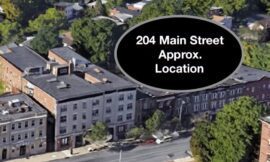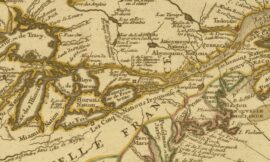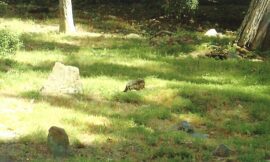African Heritage
Black Burial Grounds: Cedar Hill
One of the few African American burial grounds mentioned in Poucher & Reynolds Old Gravestones of Dutchess County in 1924.
Posted in: African Heritage, For everyone

Black Burial Grounds: Poughkeepsie
Given the negligence in keeping records of the burial of persons of color historically, we often rely on other than an ideal primary source such as a cemetery burial record. In this situation we rely on an 1870 Poughkeepsie newspaper account that quotes an older resident as saying, upon discovery of multiple coffins and human remains while digging at the equivalent of what is today 204 Main Street (between Washington & Vassar Street, south side), that this was a “Negro burial ground” created by a slave owner “near the vicinity” between 1800 and 1810. Above: click to enlarge.
Posted in: African Heritage, For everyone
Black Burial Grounds: Beacon
The Walter M. Patrice online library is a living, growing resource. Please encourage further work in studies of the local men, women and children of African descent.
Posted in: African Heritage, For everyone

Sophia Pooley: In Her Own Words
Benjamin Drew published the book, The Refugee: or the Narratives of the Fugitive Slaves in Canada in 1856, capturing narratives of freedomseekers in first person testimony. Among the narratives is that of Sophia Pooley, who was born and raised ten miles south of Poughkeepsie in Fishkill. At the age of seven she was sold into slavery in Canada, this would have been around 1769. She is 90 years old when telling her story. We are grateful to Bard College Professor Christian Crouch for directing us to this material. Recommended Reading: Verbatim from the book: Sophia Pooley. I was born in Fishkill, New York State, twelve miles from North River. My father’s name was Oliver Burthen, my mother’s Dinah. I am now more than ninety years old. I was stolen from my parents when I was seven years old and brought to Canada; that was long before the American Revolution. There were hardly any white people in Canada then–nothing here but Indians and wild beasts. Many a deer I have helped catch on the lakes in a canoe: one year we took ninety. I was a woman grown when the first governor of Canada came from England: that was Gov. Simcoe. My parents were slaves in New York State. My master’s sons-in-law, Daniel Outwaters and Simon Knox, came into the garden where my sister and I were playing among the currant bushes, tied their handkerchiefs over our mouths, carried us to a vessel, put us in the hold, and sailed up the river. I know not how far nor how long–it was dark there all the time. Then we came by land. I remember when we came to Genesee,–there were Indian settlements there,–Onondagas, Senecas, and Oneidas. I guess I was the first colored girl brought into Canada. The white men sold us at Niagara to old Indian Brant, the king. I lived with old Brant about twelve or thirteen years as nigh as I can tell. Brant lived part of the time at Mohawk, part at Ancaster, part at Preston, then called Lower Block: the Upper Block was at Snyder’s Mills. While I lived with old Brant we caught the deer. It was at Dundas at the outlet. We would let the hounds loose, and when we heard them bark we would run for the canoe–Peggy, and Mary, and Katy, Brant’s daughters and I. Brant’s sons, Joseph and Jacob, would wait on the shore to kill the deer when we fetched him in. I had a tomahawk, and would hit the deer on the head–then the squaws would take it by the horns and paddle ashore. The boys would bleed and skin the deer and take the meat to the house. Sometimes white people in the neighborhood, John Chisholm and Bill Chisholm, would come and say ‘t was their hounds, and they must have the meat. But we would not give it up. Canada was then filling up with white people. And after Brant went to England, and kissed the queen’s hand, he was made a colonel. Then there began to be laws in Canada. Brant was only half Indian: his mother was a squaw–I saw her when I came to this country. She was an old body; her hair was quite white. Brant was a good looking man–quite portly. He was as big as Jim Douglass who lived here in the bush, and weighed two hundred pounds. He lived in an Indian village–white men came among them and they intermarried. They had an English schoolmaster, an English preacher, and an English blacksmith. When Brant went among the English, he wore the English dress–when he was among the Indians, he wore the Indian dress,–broadcloth leggings, blanket, moccasins, fur cap. He had his ears slit with a long loop at the edge, and in these he hung long silver ornaments. He wore a silver half-moon on his breast with the king’s name on it, and broad silver bracelets on his arms. He never would paint, but his people painted a great deal. Brant was always for making peace among his people; that was the reason of his going about so much. I used to talk Indian better than I could English. I have forgotten some of it–there are none to talk it with now. Brant’s third wife, my mistress, was a barbarous creature. She could talk English, but she would not. She would tell me in Indian to do things, and then hit me with any thing that came to hand, because I did not understand her. I have a scar on my head from a wound she gave me with a hatchet; and this long scar over my eye, is where she cut me with a knife. The skin dropped over my eye; a white woman bound it up. [The scars spoken of were quite perceptible, but the writer saw many worse looking cicatrices of wounds not inflicted by Indian savages, but by civilized (?) men.] Brant was very angry, when he came home, at what she had done, and punished her as if she had been a child. Said he, “you know I adopted her as one of the family, and now you are trying to put all the work on her.” I liked the Indians pretty well in their place; some of them were very savage,–some friendly. I have seen them have the war-dance–in a ring with only a cloth about them, and painted up. They did not look ridiculous–they looked savage,–enough to frighten anybody. One would take a bowl and rub the edge with a knotted stick: then they would raise their tomahawks and whoop. Brant had two colored men for slaves: one of them was the father of John Patten, who lives over yonder, the other called himself Simon Ganseville. There was but one other Indian that I knew, who owned a slave. I had no care to get my freedom. At twelve years old, I was sold by Brant to an Englishman in Ancaster, for one hundred
Posted in: African Heritage, For everyone
Black History Featured Collections
Highlights People 1941 VOICES Interviews of Manet Fowler Places AME Zion Church The Walter M. Patrice Collection Things Freedom For Sale Man purchases own freedom Words from the past Newer Perspectives Other Starting Points The Walter M. Patrice Collection focuses largely on the history of the Smith AME Zion Church in Poughkeepsie, which through Mr. Patrice’s efforts was listed on the national historic register. Although unable to part with the photo album, Mr. Patrice allowed DCHS to take photographs and use the images from his mother’s family’s photo album. In most cases, his mother was not able to identify specific individuals (aside from her father, Jasper Jackson) but she confirmed that it is the family album of Henry and Alma Jackson of the Town of Milan. Below right are some striking images by Reuben Van Vlack of men preparing to serve in World War One in 1918.
Posted in: African Heritage, For everyone
DCHS Yearbook Encore Editions: A Century of Writings Related to Local Black History
Click bottom right full screen icon for best viewing:
Posted in: African Heritage, Yearbook
Manet Fowler Interviews 1941
Under the heading, Dutchess County Defense Attitudes, the anthropologist Manet Fowler, early in her career, conducted interviews among Blacks in Dutchess County. She made three trips that included Poughkeepsie, Beacon, and a handful of small towns. We are not sure under whose auspices or direction these were conducted. A profile of Fowler is provided at right, including her obituary and some local newspaper references. She was for a time, Professor at Bard College and resident of Millbrook. When you click on any file, the pdf viewer will launch it in full view for best reading. To close the full view, and return to this page, either press the escape key on your keyboard, or click on the full screen icon that will be at the bottom right of your screen. March 29 and 30, 1941City of Poughkeepsie April 5 and 6, 1941City of Beacon May 9 and 10, 1941Multiple Towns
Posted in: African Heritage, DCHS Collections & Archives

